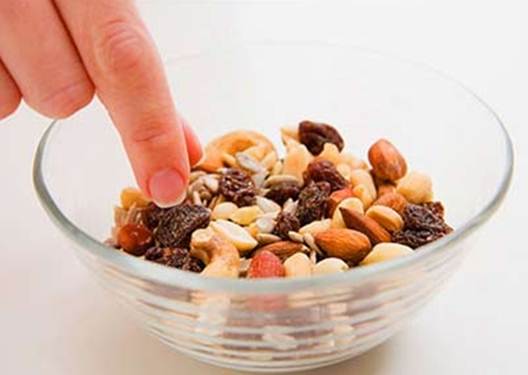When was the last time you were really
hungry? If you’re even a little bit aware of modern nutrition advice, you’ll
know that eating small meals often or “grazing” is the number one tip for
keeping your blood sugar stable and your weight in check. It’s why we’ve
obediently started stocking up on snacks, reaching for a handful of nuts or
muesli bar as soon as our tummies whisper the slightest rumble.

The
cookie counter – don’t think you’re much of a snackaholic? Keep a food diary
for a week and you might be surprised at how often you’re reaching for that
biscuit jar!
While it’s true that a stable blood sugar
level is key to avoiding those roller-coaster-style energy dips and keeping
your body running efficiently, research suggests that we may have taken the
grazing concept a little too far.
One recent UK survey found that 42 per cent
of office workers stacked on up to a stone in just one year due to their
desk-bound munching habits. And the main reasons they gave for reaching for the
biscuit tin? Not to stave off hunger or fuel up for a workout, but because they
simply felt bored or tired.
The catch is, humans are designed to be
able to withstand periods of fasting. In fact, our hormones are specifically
created to manage this. When you don’t eat, the hormone glucagon is released to
mobilize energy, while grazing constantly produces insulin, which can lead to
fat storage. And, chronic high insulin is a risk factor for many diseases,
including heart problems.
Balancing act
So where do you draw the line when it comes
to snacking? The answer, of course, is somewhere in the middle. Just as grazing
all day is unhealthy, so are long gaps between meals, followed by huge
blowouts. Long periods without food can raise the stress hormone cortisol,
which also promotes fat storage and spikes blood pressure. Timing is everything
her: new research by the Salk Institute for Biological Studies in the US
suggests that when you eat can be just as important as what you eat when it
comes to weight. The study showed that if you’re still snacking late at night,
the disruption to your body clock could lead to weight gain – even if you’re
not eating more calories than usual.
Sensible snacking
The ideal eating plan is still built around
three well-balanced meals and two balanced snacks a day, at sensible hours. And
when we say balanced, that means that all meals and snacks should contain the
correct ratios of protein, carbs and good fats to keep blood sugar steady and
fuel your body, as well as enabling it to build and repair effectively.
Think of your snacks as a plug between long
means rather than as a way to break up a boring day at work or a treat to cheer
you up. Gaps between meals and snacks shouldn’t exceed four hours: if you have
breakfast at 7am, eat a snack at 10am and lunch at 1pm. Follow it up with an afternoon
snack at 4pm and dinner between 7pm and 8pm.
And if after all that you’re still craving
a little something more, try these top tips for keeping those pesky munchies at
bay…

42%
of office workers put on up to a stone in one year due to their desk-bound
munching habits
Snack-busters
·
Ask yourself why
You don’t have to be hungry to crave food –
you might be bored, tired or angry instead. In these cases, food doesn’t solve
the problem, it just adds to it now you’re bored and you’ve just inhaled 400 calories!
Analyse your feelings before you reach for that sneaky treat. Try writing down
how you feel, or even saying it out loud, to acknowledge and accept it.
·
Look out for a distraction
So you’re not really hungry? Distract
yourself until the craving passes. Go for a walk for a change of scene. Take
your laptop to another location in the office, take the kids to the park, even
just move rooms if you’re sitting around at home. You could also do a few
exercises to lift your mood, or sit somewhere quiet and listen to your favorite
music for five minutes.
·
Change what you’re eating
If you fancy a snack around 3pm because
your energy is dipping, the solution is not to snack, but to sort out the
reason you feel tired mid-afternoon. Usually, it’s because you opted for
refined carbs at lunch, making your blood sugar shoot up, then plummet, causing
an energy slump. Instead of sandwich or pasta at lunch, go for a salad or a
soup with less starch. And pass on the lunchtime coffee or caffeinated soft
drink and you’ll feel less exhausted later on.

Stomach growling? Fill up on protein…
The problem with classic snack foods is
they tend to be carbs and fat heavy but contain very little protein, which you
need to feel satiated. Try these options for a healthy, filling fix.
Black bean dip
This G’nosh dip is rich in protein - $4,
Ocado
Low-fat yoghurt
Try a dollop of Onken with berries - $2,
Waitrose
Raw, unsalted nuts
A small handful will take the edge off -
$3, Tesco
Houmous
Great with veggies or oatcakes - $1.5,
Tesco
Vegetable sticks
Dip crudités into cottage cheese or
houmous.